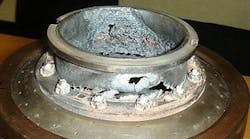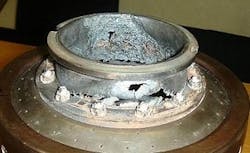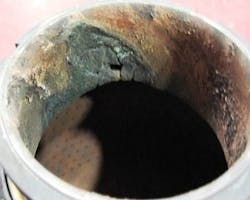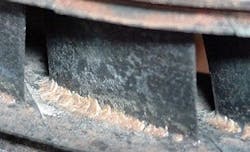Contaminants’ impact on gas turbine operation
Turbomachinery Symposium
Michael Welch, industry marketing manager — oil & gas, and Brian Igoe, FEED team proposal manager, at Siemens UK, will present “Combustion, Fuels and Emissions for Industrial Gas Turbines” at the 43rd Turbomachinery/30th Pump Symposia in Houston on Sept. 23 at 8:45 AM. The tutorial will cover the importance of minimizing the environmental and economic impacts of gas turbines used in oil and gas applications and the fuels they burn. Many types of gaseous and liquid fuels that can be used in industrial gas turbines, as well as the two basic types of combustion systems, will be discussed in this tutorial. Some common contaminants found in fuels and the impact they have on the operability and maintenance of an industrial gas turbine also will be covered. Topics of discussion will include exhaust emissions and regulations, combustion systems, fuel quality requirements, pipeline-quality natural gas fuels, operational impact of contaminants, and the proper storage of fuels. Learn more about the 43rd Turbomachinery/30th Pump Symposia at http://pumpturbo.tamu.edu.
Modern highly efficient gas turbines rely on high-quality alloys to allow increased firing temperatures to be achieved, while still maintaining acceptable product life. To ensure this is achieved, far more attention on the composition of the fluids, from all sources, entering the gas turbine is necessary, including air, lubricating oil, and fuels. Gas turbines can and do use a wide range of gaseous and liquid fuels. Fuel quality and storage both have fundamental requirements that must be addressed.
All gas-turbine OEMs provide comprehensive specifications covering the fuel quality permitted for use in the gas turbine. These are used to ensure fuel quality is defined at the onset of a project and throughout the lifetime of the turbine and are prepared for good reason — to ensure acceptable turbine operation is achieved with little or no impact on major turbine component life. It is necessary therefore to understand the fuel composition and the supply conditions in more detail so that measures can be taken to minimize the impact of any constituents of the fuel gas or the contaminants contained within it. Identification of contamination has become particularly necessary as this can have a detrimental impact on exotic materials used in turbine blading. In some instances, constituents of and contaminants within the fuel can impact combustion emissions, whether the turbine is fitted with a diffusion flame or a dry low emissions combustor.
Compositions of gaseous fuels can vary quite widely depending on their sources. Pipeline-quality gas is regarded as a suitably clean fuel but associated, or wellhead, gas may be the source, or the fuel gas may be derived from waste streams from industrial processes. Liquid fuels are also commonly used, mainly as a backup fuel but sometimes as the primary fuel, and these can also contain potentially harmful contaminants.
Contaminants of potential concern include:
- higher hydrocarbons
- water
- inert gases (nitrogen and carbon dioxide)
- sulfur
- carbon monoxide
- hydrogen
- alkali metals (sodium and potassium) and heavy metals (vanadium, nickel, and lead)
- solids
- organic contaminants (tars, asphaltenes).
Higher hydrocarbon species
Associated gas from oil production is a common gas turbine fuel. Methane is usually the major constituent but associated gases can be rich, containing considerable quantities of heavier hydrocarbons — ethane, propane, butane, pentane, and potentially even longer hydrocarbon chains. In some instances, heavier hydrocarbons may be considered a waste product from gas processing and can be either used on their own — ethane, propane, LPG — as a gaseous fuel or deliberately blended into a methane-rich gas and used as a gas-turbine fuel as a means of disposal. Higher hydrocarbons can also be used in liquid form; there are numerous gas turbines operating on LPG and naphtha fuels.
The presence of higher hydrocarbon species in a gas fuel can lead to auto-ignition problems within the combustion system. The longer hydrocarbon chains can ignite spontaneously at temperatures below the compressor discharge temperature, so it is important to minimize the residence time of the fuel gas in the combustor so that controlled combustion occurs in the correct place.
Figure 1. If the gas fuel temperature isn’t maintained, condensate can impinge on combustor surfaces leading to localized burning and component failure, which can occur very rapidly and result in engine shutdown.
Higher hydrocarbon species impact the hydrocarbon dew point of the gas fuel, and hence high supply temperatures are required to ensure these remain in the gaseous phase. If the gas fuel temperature is not maintained, then liquid dropout — condensate — will result and can cause problems in the fuel system or, more seriously, impinge on combustor surfaces leading to localized burning and component failure (Figure 1).
When used as a liquid fuel, the issue is now to keep the fuel in liquid form until it reaches the burner tip. This is achieved by using high fuel supply pressures or by a combination of slightly increased pressure and special burner designs that use the latent heat of evaporation to cool the fuel in the burner. When heavy hydrocarbons are used in liquid form, special consideration must be given to the fuel system. For example, LPG has low viscosity and associated low lubricity requiring special pumps to overcome this problem. Control of the fluid is critical to ensure other problems are avoided such as:
- waxing (fuel temperature too low)
- exceeding flash point (temperature too high)
- corrosion (particularly where copper is present)
- vapor lock due to premature vaporization of liquid.
Higher hydrocarbon liquids, or condensate, when passed into the combustor, can combust in an uncontrolled manner, thus having a detrimental effect on operation and safety. Combustion of unmetered higher hydrocarbons can result in combustion hardware damage or failure, such as the burner gas gallery and passage blockage due to carbonization, as well as damage to downstream hot gas path turbine components. The higher temperatures required for gas fuels with high levels of higher hydrocarbon species has some additional considerations in package design, such as the requirement for trace heating and lagging of the gas supply pipework and fuel system.
The presence of higher hydrocarbons can impact the emissions signature of a gas turbine. The longer hydrocarbon chains result in a higher flame temperature within the combustor, increasing the NOx emissions, even when dry low emissions combustors are used. In liquid form, NOx emissions will be similar to those produced when operating on diesel fuel. NOx formation can occur in a number of ways, but thermal NOx is by far the most dominant. Therefore, anything done to increase the combustion temperature, such as using fuels with higher hydrocarbon species, will have a detrimental impact on NOx emissions to atmosphere.
Water
Pipeline-quality gas fuels are usually clean and dry, but there are occasions when fuels contain water, the presence of which can be problematic.
- Free water in the presence of hydrogen sulfide or carbon dioxide can form acids which can be highly corrosive to the fuel system and associated pipework.
- Water may contain undesirable water-soluble contaminants, such as alkali metals.
- The presence of water impacts the dew point (water dew point), and hence supply temperatures will be higher than for the equivalent dry gas.
Water in gaseous fuel can be tolerated, subject to correct control over dew point, but the water contained in distillate fuels is most concerning. It can be seen as dissolved, emulsified or free water.
- Dissolved water is chemically dissolved or absorbed into the fuel (for example, sugar dissolved in hot drinks).
- Emulsified water is tiny droplets of water suspended in the fuel, making it milky in appearance.
- Free water falls out of suspension and gathers at the bottom of a storage tank.
It is these latter two types, emulsified and free water, which are of most concern, resulting not only in fuel system and engine damage, but also the promotion of bacterial growth. Removal of water, along with any bacterial growth, using best industrial practices should be considered. Water and sediment can be removed or reduced by filtration and centrifuge separation. This is the same for any liquid fuel and prevents the formation of corrosive elements and bacterial growth, a precursor to fuel degradation. Removal of the water also reduces the levels of water-soluble contaminants such as the alkali metals sodium and potassium.
Inert gases: Nitrogen (N2) and carbon dioxide (CO2)
Many associated gases and biogases contain inert gases, often in significant quantities as high as 50% by volume. While these gases are generally benign, CO2 can react in the presence of moisture producing a weak acid. Generally gas turbines are able to operate on gases with high inert gas contents.
Inert gases act as a diluent, reducing the heat content available in the fuel, and so greater fuel volumes are required to achieve the same output power, compared to standard natural gas. This necessitates a redesign of the fuel system to handle the higher gas volumes and potentially the need to enlarge the burner gas passages and injectors. The higher mass flow caused by the need for greater fuel volumes can boost the power output available from the gas turbine, provided other design limits are not exceeded.
From a NOx emissions perspective, inert gases help to reduce the NOx emissions in all types of combustors, as they quench the flame temperature and reduce the formation of thermal NOx. Both combustor rig testing and operational experience have demonstrated that the presence of elemental nitrogen in the fuel gas does not increase NOx emissions. However, this is not the case for fuel bound nitrogen (FBN), for example, if constituents such as ammonia (NH3) are present in the fuel gas; in this instance, high FBN-to-NOx conversion ratios have been observed.
Sulfur
Sulfur can occur in both gaseous and liquid fuels. In gas fuels it is usually present as hydrogen sulfide (H2S), although elemental orthorhombic sulfur occurs in shale gas. Liquid fuels, especially heavy fuel oils, can contain very high levels of sulfur, although increasing legislation is driving operators to use low sulfur diesels or fuel oils.
Hydrogen sulfide is highly toxic and can pose unique challenges to operators, as well as in the operation of gas turbines. Besides specific health and safety requirements, H2S (also sulfur in liquid fuels) can combust producing SOx (SO2/SO3) emissions to atmosphere, which react in the presence of moisture resulting in weak acid production (acid rain). Where SOx legislation exists, treatment of the fuel at source to remove or lower H2S (or sulfur in liquid fuels) is necessary. As well as the environmental issues caused by SOx, it can also have an impact on the design of waste heat recovery units (WHRUs) and the overall energy efficiency of cogeneration plants; stack exit temperatures on the WHRU must stay higher than normal, and boiler feedwater temperatures elevated to prevent acid gas condensation within the chimney or the economizer, as this can lead to metal corrosion.
Figure 2. The reaction of sodium, potassium, or vanadium with sulfur results in the production of sodium and potassium sulfates or vanates, which are highly corrosive to modern materials used in the hot gas path components.
In the presence of sodium, potassium, or vanadium, contaminants commonly found in air in off-shore or in coastal environments or in liquid fuels, further assessment will be required as the reaction of these metals and their salts with sulfur results in the production of sodium and potassium sulfates or vanates, which are highly corrosive to modern materials (for example, nickel alloys) used in the hot gas path components, such as turbine nozzles and rotor blades. Such corrosion can occur after many operating hours (Figure 2). Older turbines with lower operating temperatures and using components with high chromium content show more resistance to attack from sulfur compounds and may be a more reliable option if a gas turbine is required to operate on high sulfur content fuels. There are proprietary methods available to remove sulfur from both gaseous fuels and from liquid fuels.
Hydrogen and carbon monoxide
These readily combust but require special understanding before they can be accepted as a gas turbine fuel. Both exacerbate combustor flame speed and can result in flashback, where the flame velocity exceeds the local combustor velocities. This makes these types of fuels less suited for lean pre-mix type combustion systems. However, conventional diffusion flame combustion systems are more tolerant to such fuels, subject to full assessment and application of appropriate safety measures. One aspect to consider is hydrogen embrittlement, therefore delivery systems and pipework have to be of suitable materials. Martensitic steels are particularly susceptible, so the use of suitable stainless steels must be considered.
Alkali metals and heavy metals
While alkali metals, especially sodium, can be found mainly as airborne contaminants, both alkali metals and heavy metals occur as contaminants in liquid fuels, especially heavy fuel oils and crude oils.
Such fuels need to be treated in order to meet industrial gas turbine limits for alkali metals (sodium, potassium) and heavy metals (vanadium, nickel), which, if introduced into the combustion system, can result in accelerated deposit formation and high temperature corrosion in gas turbine hot gas path components. The metallic contaminants react with oxygen and with any sulfur present to form highly corrosive compounds. Major corrosive constituents include vanadium pentoxide (V2O5), sodium sulfate (Na2SO4) and aggressive low melting forms in the Na2SO4–V2O5 and Na2O-V2O5 systems. Determination of the ash sticking temperature is usually a good feature to use and should be higher than 900 °C if corrosion of the blade is to be avoided. While alkali metal contamination can be reduced by removal of any water in the fuel, vanadium and other heavy metals are oil-soluble and can only be treated through chemical dosing, so that combustion creates high melting temperature compounds. A magnesium-based additive is commonly used to treat fuels with heavy metal contamination, and, while this reduces the risk of high temperature corrosion, it increases the frequency of turbine washing to maintain performance.
Organic contaminants: Tars and asphaltenes
Figure 3. Siloxanes tend to be converted in the combustion process into silica-oxide compounds, which sublime in the turbine section of the gas turbine resulting in hard, glass-like, deposits that impact performance of the turbine.
Tars tend to be present in small quantities in process gas fuels, such as those from the conversion of coal to coke, resulting in production of coke oven gas. Asphaltenes are small solid particles found in some distillate fuels. These can combine to form a more homogenous mass affecting the filtration system or collect at the bottom of storage tanks forming a sludge-like substance.
Biogas
Biogas tends to cover gaseous fuels derived from the decomposition of waste, such as in a landfill or digester or waste water treatment. These gas fuels contain a unique contaminant in various amounts. Silica used in modern health and beauty products result in a complex range of silica-based compounds being found in landfill gas and digester gas. Under the generic name, siloxanes, these tend to be converted in the combustion process into silica-oxide compounds, which sublime in the turbine section of the gas turbine resulting in hard, glass-like, deposits which impacts performance of the turbine (Figure 3). Treatment of the raw gas before passing to the gas turbine is the only way to prevent these deposits, and there are several proprietary methods to limit siloxanes in biogas fuels.
Fuel storage
Mostly related to liquid fuels, the storage and maintenance of such fuels can be the difference between acceptable turbine operation and one where extensive site maintenance may be required. Storage of fuel comes under the general heading of fuel handling best practices, some aspects of which are highlighted.
- It is necessary to ensure fuel is sourced from good suppliers to approved specifications.
- Routine monitoring and recording from sampling and analysis of fuels is critical to achieving good turbine operation.
- Applying best industry practice in receipt, unloading, storage, and transfer of liquid fuels is essential to achieving and maintaining fuel to the highest standard and quality.
- Using centrifuges, filters, and coalescers at each storage tank will help to maintain the fluid in the correct condition.
- Ensure tank design meets best industrial standards, including but not limited to floating suction take-off to supply the gas turbine; bottom drain for sediment and water; and allowing for sufficient settling time after introducing new supply to tank.
- Turning over the liquid fuel (using it all on a regular basis) minimizes deterioration and will also help in the long term quality control of the fuel.
Conclusions
The understanding of fuels used in modern high-performance, high-efficiency gas turbines and the contaminants contained within these fuels is critical in achieving the goals of high availability and reliability, but at the same ensuring the environmental requirements are fully met. Supply of the fuels of the right quality, or with the correct fuel treatment and handling methods, can result in achieving these goals, while the use of fuels outside the advised specifications can result in increased maintenance requirements or premature component failure.






